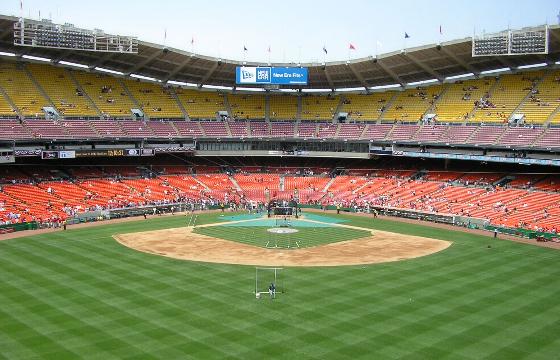 RFK Stadium, as seen from the Whitney Young Bridge (East Capitol Street), Jul-2005. |
 The stadium interior, including the undulating roof sections, from center field. |
 A game, as seen from the upper deck. |
 RFK Stadium, as seen from the Whitney Young Bridge (East Capitol Street), Jul-2005. |
 The stadium interior, including the undulating roof sections, from center field. |
 A game, as seen from the upper deck. |
 Chronological Tour: Stop 291 Chronological Tour: Stop 291 |


 3 baseballs
3 baseballs
The Senators moved to Arlington, Texas, to become the Texas Rangers for 1972, leaving the nearest major league ball to the nation’s capital 40 miles northeast in Baltimore. The ballpark, which had also hosted Howard University baseball in the 1960s, became strictly a football and soccer venue until 2005, when Major League Baseball relocated the Montréal Expos to Washington, adopting the Nationals nickname and staying here for three seasons. While the Redskins moved to Landover, Md., in the late 1990s, the stadium remained home to the D.C. United franchise of Major League Soccer for another ten years after the Nationals moved to their new ballpark in the Navy Yard district.
Seating here is in five sections, three in the lower deck and two in the upper deck. All three lower-deck sections have orange seats, while in the upper deck, the 400 level features red seats while 500-level seats are yellow. Some of the 500-level seats have not been replaced since the park’s opening; these are wooden seats which may have been repainted but otherwise have not been improved.
RFK has both advantages and disadvantages to the spectator. On the plus side, the sight lines are excellent from the majority of the seats, although some seats in the 300 section (the highest section of the lower deck) have obstructed views. This is no problem for football or soccer, but it makes tracking fly balls exceedingly difficult. In addition, with no luxury box level between the decks, seats in the upper deck are unusually close to the action for a 1960s “doughnut”.
On the minus side, the outer concourses and walkways are quite narrow, and egress in particular can be a pain on a night when the park gets filled near capacity. In addition, the concessions are below par. I was advised to stay away from the food, and I did; a friend told me that the chicken-fingers-and-fries platter, a favorite order of mine at many ballparks, was merely so-so. With the entire field enclosed, there is no view (then again, the field faces east, and Washington’s sights are west of the park). Finally, the scoreboard in right-center field, a matrix board, is smaller than usual, making it difficult to pick up game information if your eyesight is subpar.
On the day I attended in 2005, the matrix board operators forgot to load current stats into the computer to display with the batters’ names. The stat display had to be turned off for about two innings until the upload was complete. It was the Fourth of July, and a day game to open a series, but the failure still seemed strange.
All in all, though, I enjoyed visiting the park, which got closed out for the second time 23-Sep-2007 with a Nationals victory over Philadelphia. Ticket prices at RFK were low enough that the Nationals drew a broad base of fans. Naturally, prices rose at the new park when it opened in March 2008.
With D.C. United moving to its own soccer-specific stadium for the 2018 season, RFK Stadium fell into disuse and city commissioners sought to tear it down. A contract was finally settled for the demolition in September 2020, and the facility was in the process of being torn down by late 2022.
| Game | Date | League | Level | Result |
|---|---|---|---|---|
| 749 | Mon 4-Jul-2005 | Major | MLB | NY Mets 5, WASHINGTON 2 |
| 867 | Wed 4-Jul-2007 | Major | MLB | WASHINGTON 6, Chi Cubs 0 |
| 914 | Sun 23-Sep-2007 | Major | MLB | WASHINGTON 5, Philadelphia 3 |